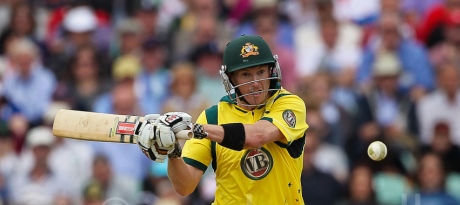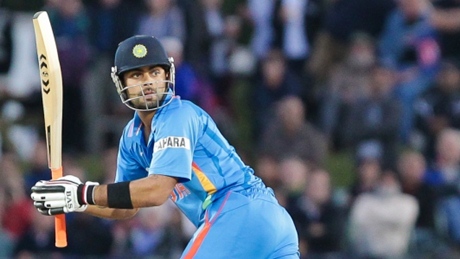
Yesterday, the man they used to call Nohit Sharma made a one-day double hundred, but even eight wickets down, Australia seemed in with a chance of chasing their 384 run target. Ludicrous totals seem to have become the norm in one-day internationals (ODIs) and even India’s captain has been complaining about things. What’s going on?
The bigger picture
The first thing to note is that this isn’t a global thing. In general, fewer runs have been scored per over in 2013 (5.07) than were scored in 2009 (5.12) and roughly the same as were scored in 2011 (5.04) and 2012 (5.05). The narrative that one-day cricket is increasingly all about six-hitting and phenomenal scoring rates only really makes sense if you focus on certain matches.
Even then, it’s not been quite so outlandish as you might think. India’s 383-6 yesterday was the highest total of the series, but in historical terms, it was only the 19th highest. Their 362-1 in Jaipur earlier in the series has been the second-highest total of the year, but is only the 34th highest in history.
So why do things seem so crazy-mental?
It definitely feels like everything’s gone nuts though, doesn’t it? If there has been a change, it has been towards the end of the innings. For example, Rohit Sharma took 71 balls to reach 50, but then hit 59 off the final 18 balls he faced with seven of those deliveries going for six. Batsmen have always looked to accelerate, but this appears to have become more pronounced in recent times.
Sharma and MS Dhoni scored at 10.65 an over during their 167-run partnership, while earlier in the series, Sharma and Virat Kohli scored 186 runs at 10.73 an over. This is not just very attacking batting – it is also sustained, which implies there is less risk of being dismissed.

Minor factors
The easiest and laziest thing to do is to point to Twenty20 cricket. There are certainly contributory factors arising from that format – a change in mentality and increased focus on the methodology of hitting sixes – but it’s also true that it’s been around a while. The IPL’s been up and running since 2008 and Twenty20’s been played in England since 2003.
People also point to flat pitches being produced in India, but there’s nothing new there either. Pitches can only get so flat. Every 10-run rise in score isn’t indicative of another degree of flatness. These things are probably contributing to high scores, but there is more going on.
Major factors
We’d point to two relatively recent changes in playing conditions as being the major reason why back-end scores (fnar fnar) have risen in recent times. Since the start of this year, ODIs have been played with two white balls (fnar fnar) and each team has only been allowed four fielders outside the circle outside the powerplay overs.
Having two white balls was meant to give something back to the bowlers because the new ball is usually more threatening to batsmen. However, many Indian pitches feature relatively little bounce and so this advantage doesn’t actually amount to a right lot. In fact, the benefits to the bowlers are far outweighed by the fact that a harder, newer ball will travel further off the bat later in the innings. Last year’s caught-on-the-boundary-in-the-40th-over is this year’s six.
And with four men out on the fence, there is always a sizeable gap somewhere. Loft a shot in that direction and you will probably get six and will have to settle for four if you mishit it.
Basically, the batsmen have been encouraged to try and hit boundaries by the removal of one of the boundary fielders and have been given greater hitting power by the use of two white balls.
Other factors
Then there’s the bowling. Clint McKay, Nathan Coulter-Nile, James Faulkner, Xavier Doherty and Glenn Maxwell. Let’s be brutally honest here – that’s a B-team. This is a recurring theme in one-day cricket these days. Fast bowlers in particular require a great deal more rotation than batsmen, so you invariably end up with the best batsmen from one country facing the second-best bowlers from the opposing nation. There’s imbalance there, even excluding all the other factors.

Does any of this matter?
Unlike Test cricket, where the aim of the game is to take 20 wickets (while minimising the damage sustained in achieving that), one-day cricket is about run-scoring. That is the unit of measurement. The team which scores most runs, wins. As such, higher totals are not intrinsically a bad thing.
The problem is that there comes a point where you are not rewarding the best batsmen, you are just rewarding batsmen in general. While Virat Kohli may be an exceptional talent, few would argue that the likes of George Bailey and James Faulkner are in the same bracket and yet they have scored heaps of runs at astonishing rates. It seems to us that in India specifically, the current ODI rules tip things too far in favour of the batsmen.
Batting is essentially about weighing risk and playing accordingly. The best batsmen are at less risk, no matter what the shot, because they hit more cleanly and consistently. However, we now have a situation where even a mediocre batsman can aim to hit a six with minimal risk because there are bigger gaps and because a newer ball will go further even when mishit.
A question
Weather, pitches and cricket balls vary from country to country. Why do ODI rules need to be the same worldwide?


The last point about cricket balls is an interesting one. As I sit down to watch the grand prix with this years magic disintegrating tyres I’m grateful that the various boards have resisted the temptation to ‘custom order’ a ball to conditions.
That said… a ball which goes soft a little quicker could in theory curb run scoring in Indian conditions (which lets face it if that’s what they wanted setting the boundaries back an extra 10-20m would do the same thing).
In practice though, I suspect if a board attempted to custom order a cricket ball we would end up with magic disintegrating balls that turn ODIs into (more) of a farce.
Weather, pitches and cricket balls vary from country to country. Why do ODI rules need to be the same worldwide?
Because keeping up with worldwide rule changes is enough of an eyeball loosener as it is?
~
In other news, Bangladesh have whitewashed NZ in an ODI series for the second time in a row, while missing their best player. It was a series that featured no utterly stupid collapses from the kiwis and no where-did-that-come-from-O’Brien-s from any Bangladeshi batsmen. It didn’t feel like anyone did something worth remarking on. 3-0 to Bangladesh was, for the first time I can remember, completely predictable.
Lovely hover caption. Reminds me of the golden age of hover captions.
They are also making better bats, aren’t they? And I agree with wolf — some of the Indian grounds’ sizes is pretty small (though in agreement with the ICC rules, presumably). They should uniformly push all parts of the ground 90 yards from the center. But I don’t think even that’ll help in India. You know something is wrong with the game when Viv Richards never managed an ODI double (with 60 overs) but Rohit did. Virat, of course, would be the best ODI batsman in the game today even under the old rules – no question about it.
This could be just me, but the overall quality of bowlers around the world is also not what it used to be. Where are the Garners and the Lillees? No disrespect to the spinners, but unless he’s an exceptional talent like Warne or Murali, there’s no way a spinner can be the best bowler in the team. Today I learned that the top ODI bowlers are Ajmal, Narine, Jadeja, Finn, and Herath. Gone are the days when the bowler would instill fear in you – these days he’s busy fucking around with the ‘mystery ball’.
I’ve always thought that cricket rule changes are devised by people who have no idea how cricket is played in the subcontinent. For the 100th time, ICC — in the subcontinent, the NEW BALL IS THERE TO BE HIT. How much longer will it take the fucking idiots who run the game to realize this fact?? The old ball is the only weapon bowlers have in India, esp in ODI cricket. The 2-new ball rule completely throws the old ball out of the equation.
And yet the highest innings score in the SA versus Pak series so far has been 209, so it can’t just be the new rules. Personally I think the biggest factor is just the quality of bowling attacks versus batting lineups. Aus has a fairly ordinary bowling lineup facing off against a very good batting lineup, while India has an absolutely rubbish bowling lineup facing a mediocre batting lineup. In SA vs Pak the scenario is somewhat reversed, Pak’s bowling lineup is much better than their batting one, and the scores reflect this.
As we said in the ‘Bigger picture’ section, it’s not a global thing. The same rules have different effects in different conditions.
In India, we’ve seen a lot of factors come together at one, including some mediocre bowling.
Clearly the solution lies in devaluing runs.
Under my new system, 6’s will now be 4’s, 4’s will be 3’s, and each run will now be 0.75.
Sorted.
Either that or get rid of fielding and bowling restrictions and move the boundaries back out again. I dunno.
In a way, that is actually what happens. One problem with cricket supporters is that they think the value of a run is fixed. Why else would they compare the averages of different players? Clearly Faulkner’s hundred was worth less than one in a match where 200 was the winning team score.
The trouble is that, unlike with monetary inflation, the method of accumulating tokens (runs instead of cash) doesn’t change at the same time. When wages go up, prices go up to compensate, with the approximate result being that one day’s hard labour still buys you one skinny frappacino like it did in your granddad’s day. With run inflation, the single is devalued with no balancing factor. Singles simply count for less – it’s boundaries or nothing. So it isn’t just a case of assuming that 350 is the new 250. This has actually changed the ODI into something completely different. A closer approximation would be an ODI in which running between the wickets scores zero.
Hello. I am from New Zealand but I want to be your friend anyway.
No one who gives a shit about cricket should really give a shit about ODIs, ‘cept some day’s that’s all there is to give a shit about. Like today.
So if there is a problem, it’s that batsmen start getting picked for test cricket based on the dodgy evidence of ODI form, because there is no time to play first class cricket any more. So George Bailey will get a few up the snorter in Brizzy, and then we’ll all know.
It will be interesting to see Bailey in Tests. You can weigh a lot of relevant qualities in one-day cricket, but not all of them. A few up the snorter is one of the gaps.
As the actress said to Ian Bishop
Spot on Stephen. The same goes for Nohit Sharma, whom I still call Nohit Sharma.
He may do well at test cricket, but there are other batsmen who deserve a chance before him based on better first class records, and who now won’t get that chance.
Good points re “up the snorter”, except that the Aussie curators are presumably working day and night to produce non-deteriorating flatties that will enable the Aussie flat track bullies to thrive for five.
Don’t be surprised if we get some scorecards of the “958/6 declared, 841/4 declared, match drawn” variety. I exaggerate for effect.
841/4? Who’s scoring those runs?
That’s going to have to be an awful lot of cricket battings hittery.
Meanwhile at the Gabba:
http://aftergrogblog.blogs.com/KevinMitchell.jpg
the point about different rules for different playing conditions is well made, but (i fear) rather disingenuous. even if the administrator until theys could be persuaded to countenance the idea – and good luck with that – it’s surely unactionable..? you would need to have different rules not just for each country but for individual grounds in some cases, and for different times of day (/night)… different weather conditions… way too complicated unfortunately. instead we will all just be stuck with a set of rules which we all know are bollocks… until they bring in the next set of changes and then we can all have a good moan about them. and stephen is right, who really gives a toss about ODIs anyway? (apart from the boards who are getting rich(er) off them, natch…)
shit. how did that happen?? lines 2-3 in the comment above should read “even if the admininstrators could…”. just mentally the delete the intruding part :-S
We’re all supposing that inflation is a bad thing and cricket administrators remiss for allowing this to happen. (As if it hasn’t been deliberately engineered.)
Admittedly, fans here are dedicated preservers of ‘the way’, but there may be room for some more boundaries. Isn’t it what people want to see?
Can lots of sixes also be accompanied by sharp bowling and dramatic wickets?
Lots of sixes but with a regular flow of wickets is kind of what they’re after. The problem is that the only reason batsmen are hitting so many is because they feel there is minimal risk. If bowlers were more threatening, they wouldn’t be looking to clear the ropes anywhere near as often.
To some degree, it is what people want to see, but anyone who has watched a whole raft of Twenty20 matches knows that you become desensitised to the spectacle and that it’s the sense of jeopardy that keeps an innings absorbing.
Maybe it should be three strikes and you’re out. That way we get to see stumps flying out of the ground without the inconvenience of the batsman having to walk off.
I think it’s a culmination of plenty of these factors all upwardly aligning to create a strange hyper-reality of a series.
India bowling = terrible
Australia bowling = terrible
Virat Kohli and MS Dhoni = will go down as all time greats of ODI, Kohli already there (and not even 25 yet)
Rohit Sharma and Shikhar Dhawn = phenomenal batsmen
Two new hard balls = with minimal movement in India this is a huge advantage for the batsmen (unlike in England where it helps the bowlers, how it was intended to)
4 men outside the ring max = way less risk, huge advantage to the batsmen
boundaries brought in and bat technology = mishits going for 6
While MS Dhoni said you might as well bowl using a machine, the reality is his attack is at that level.
We ultimately need a bigger dataset to judge the effects of the changes. It seems like the main aim is to contrive more boundaries, wickets and “action” for the viewing public.
The closest thing to cricket porn is Dhoni’s 110m helicopter six. If you haven’t seen it, here it is:
http://youtu.be/KJoRKATm-CA
that’s pretty good, but surely the closest thing to porn in cricket is watching a batsman’s stumps get splayed. this is (after all) what is called penetration 🙂
Part of the reason is also the ridiculously imbalanced team that India has. I doubt there has ever been an ODI team in history with so many outstanding batsmen and so many rubbish bowlers.
In this series, this has been compunded by Australia holding back their best bowlers for the ashes (or being injured).
Case in point – Johnson and Bhuvaneshwar, the best bowlers from the respective teams, have generally gone for much less than the rest
Seeing that the average quality of bowlers out there today is rubbish, why not allow them to get their own balls to bowl, the way batsmen can pick any of their x (outrageously sized) weapo.. err, bats? So, a Steyn can pick a lopsided ball to generate extra swing, a Narine can pick something that has a pronounced, or non-pronounced seam, whichever may work best, military mediums can pick a soft ball. And they can change it every over, or as per the match situation. As long as it is visible, it should be allowed.
Glen Maxwell and John Holland found some pies to throw down today.